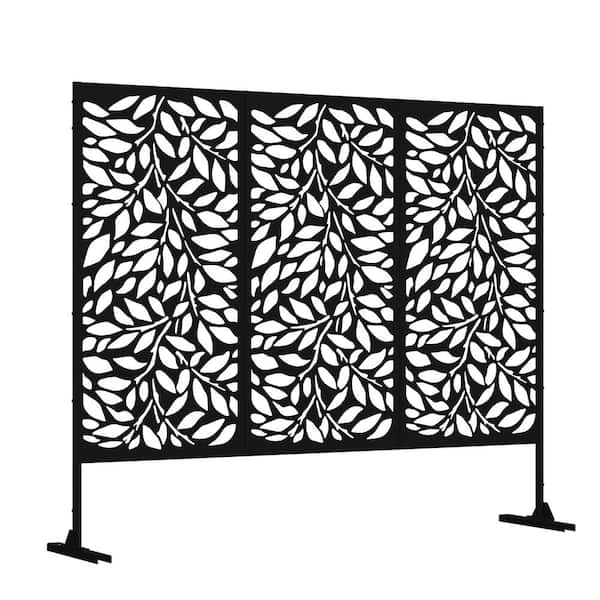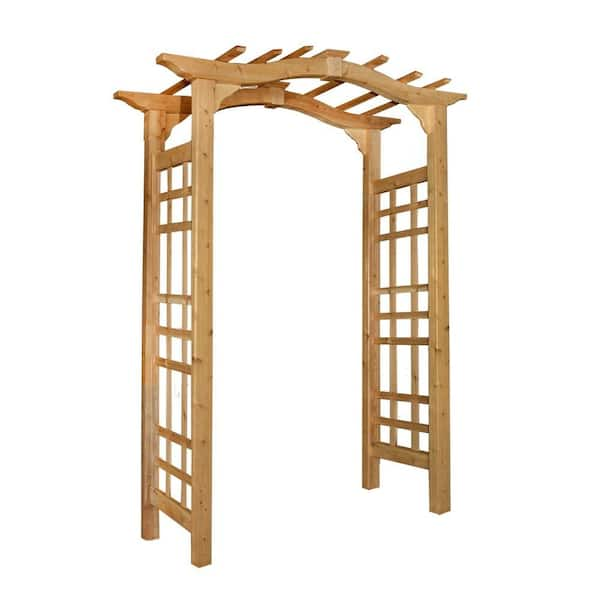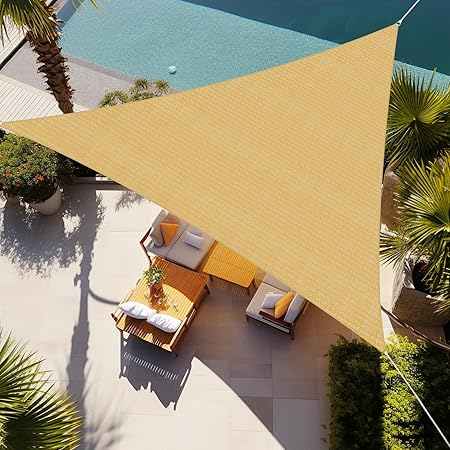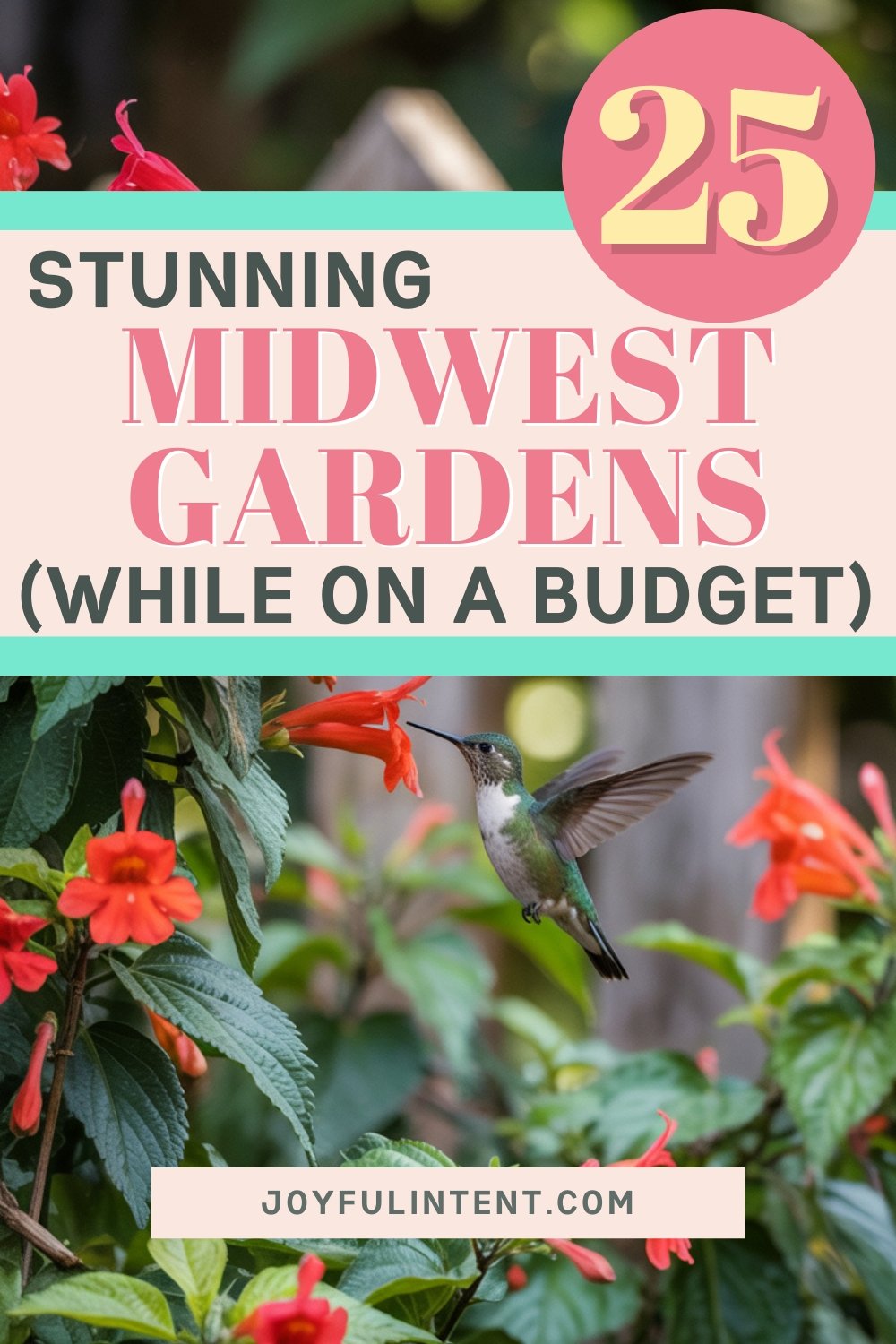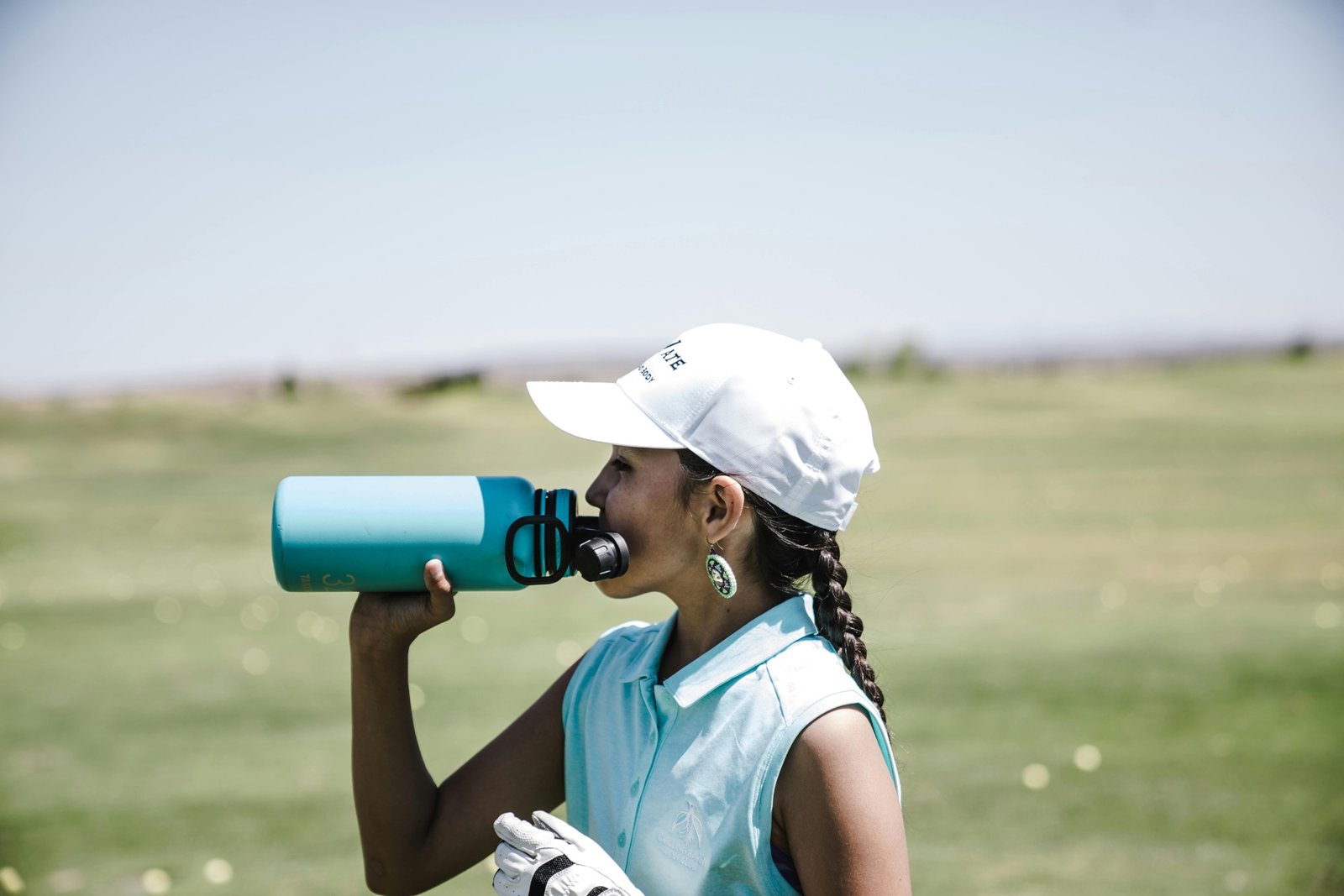23 Breathtakingly Beautiful Mobile Home Landscaping Ideas
From one busy mom to another, I know how challenging it can be to turn a mobile home yard into a safe, beautiful haven for the family. Whether you’re dealing with nosy neighbors, puddles after rain, or a yard that’s just not kid-friendly, these ideas can surely help. Here are 23 ways to improve your mobile home landscape, focusing on practical solutions for privacy, safety, and low maintenance fun.
Some of the links in this post are affiliate links, which means I may earn a small commission (at no extra cost to you) if you choose to make a purchase. I only share things I genuinely love or would use in my own cozy home. Thank you for your support and helping me keep the ideas coming! 💛 Affiliate Disclosure
Privacy Panels or Fencing

Create a cozy, private nook by adding inexpensive fencing or privacy panels around your yard. Even a short lattice fence or trellis can make a big difference – it gives a sense of enclosure without making your small space feel boxed in (5 Simple Outdoor Space Upgrades for Your Mobile Home). Many moms love DIY options like pre-fab fence panels or bamboo screens that are budget-friendly. Not only will a privacy fence help block the view of neighbors (and shield you from prying eyes), it can also double as a backdrop for plants or outdoor decor. Plus, it might boost curb appeal and value by clearly defining your yard’s boundaries.
Block prying eyes with these stylish lattice privacy panels – affordable, easy to install, and perfect for cozy mobile home lots.
Living Green Screens (Hedges or Vines)

For a natural privacy solution, consider planting evergreen shrubs or fast-growing hedges along your lot line. Bushy plants like holly, viburnum, or arborvitae can act as a living fence, screening your yard year-round (Creative Ideas for Landscaping Around Your Double Wide). If ground space is limited, use vertical space: train climbing vines (like jasmine or ivy) on a trellis or along your porch. This adds lush greenery and a pleasant scent while keeping your outdoor space private. The bonus is that a living screen also muffles noise and attracts birds/butterflies, creating a more peaceful, sensory-friendly yard. (Just be sure to choose climate-appropriate plants for your area – for instance, drought-tolerant natives in California.)
Bring natural privacy to life with fast-growing arborvitae or jasmine vines – shop climate-friendly picks now.
DIY Drainage Fix (French Drain or Swale)

Tired of stepping in puddles or dealing with a swampy lawn after storms? Solve those poor drainage issues with a simple French drain or swale. Basically, you dig a slight trench and fill it with gravel (and optionally a perforated pipe) to funnel water away from your mobile home’s foundation (Installing a French Drain – DIY – Nonprofit Home Inspections). This prevents rainwater from pooling under your home or in play areas. Many homeowners can install a small French drain themselves with a bit of effort (Installing a French Drain – DIY – Nonprofit Home Inspections) – just remember to check for utility lines before digging. It’s a low-cost fix that keeps your yard drier and safer (no more mud pits for the kids to slip in!), and it protects your home from moisture damage.
Rain Garden for Low Spots

If you have a persistent low spot that stays soggy, why not turn it into a pretty rain garden? A rain garden is essentially a shallow, plant-filled basin that catches and absorbs runoff (Rossen). You can DIY by digging a depression, filling it with some gravel or coarse soil, and planting water-loving natives (think colorful iris, sedges, or swamp milkweed). This natural solution not only drains water within a day or two (so no mosquito breeding) but also filters pollutants and provides a mini habitat for birds and butterflies (Rossen). It transforms an eyesore puddle into a low-maintenance, eco-friendly feature. And don’t worry – rain gardens can handle droughts too by using hardy plants, making them perfect for places like California that swing between wet winters and dry summers.
Kid-Safe Ground Cover in Play Areas

Say goodbye to muddy patches or hard falls. If you have little ones playing outside, designate a play zone with soft ground cover to make it safer. Materials like rubber mulch or engineered wood fiber (playground mulch) provide cushioning for jumps and tumbles (5 Safe & Affordable Playground Surfaces | Playground Guardian) (5 Safe & Affordable Playground Surfaces | Playground Guardian). These are commonly used in public playgrounds for good reason – they absorb impact much better than plain dirt or grass (which can be unsafe and hard (5 Safe & Affordable Playground Surfaces | Playground Guardian)). You can create a small play pit or spread the mulch under a swing set or slide. It’s an easy DIY project: lay down landscape fabric and fill a few inches deep with the mulch. Your kids get a safer play surface, and you get less grass stains and mud tracked into the house!
Fenced Play Zone for Safety

If your mobile home lot is unfenced and you worry about kids wandering off (or wandering into danger), consider adding a small fence or playpen area for peace of mind. Even a short picket fence or portable vinyl fencing can keep toddlers and pets corralled in a safe section of the yard. This is especially helpful if you live near a road or have a lot of foot traffic in the community. A fenced play zone means you can relax on the porch while the kids play, without constantly hovering. For a budget option, some moms use mesh safety fencing or even baby gates to section off an area on a deck. The goal is a secure, defined play space that feels like a backyard haven for your family. (And as a bonus, a cute white picket fence can add storybook charm and curb appeal.)
Plant a Shade Tree (or Two)

Adding a tree might be the biggestgift you give your yard – literally! A well-placed shade tree will grow to provide cooling cover over your outdoor space, making hot afternoons much more enjoyable for family playtime. Trees also help cut down on AC costs by shading your mobile home (in fact, landscaping with trees and shrubs can save money on heating and cooling bills (10 Great Landscaping Ideas for Mobile Homes)). If you have room, plant a small-to-medium tree like a crape myrtle, dogwood, or citrus (great for California climates) where it can eventually cast shade on your patio or west-facing wall. Not only will it offer relief from the sun, it breaks up the “boxy” look of a manufactured home and adds to curb appeal and value (10 Great Landscaping Ideas for Mobile Homes). Just be sure to choose a species suited to your region and give it some TLC in the first couple of years. In time, you’ll have a beautiful living umbrella for picnics, play, and maybe even a tire swing!
Quick Shade with Sails or Canopies

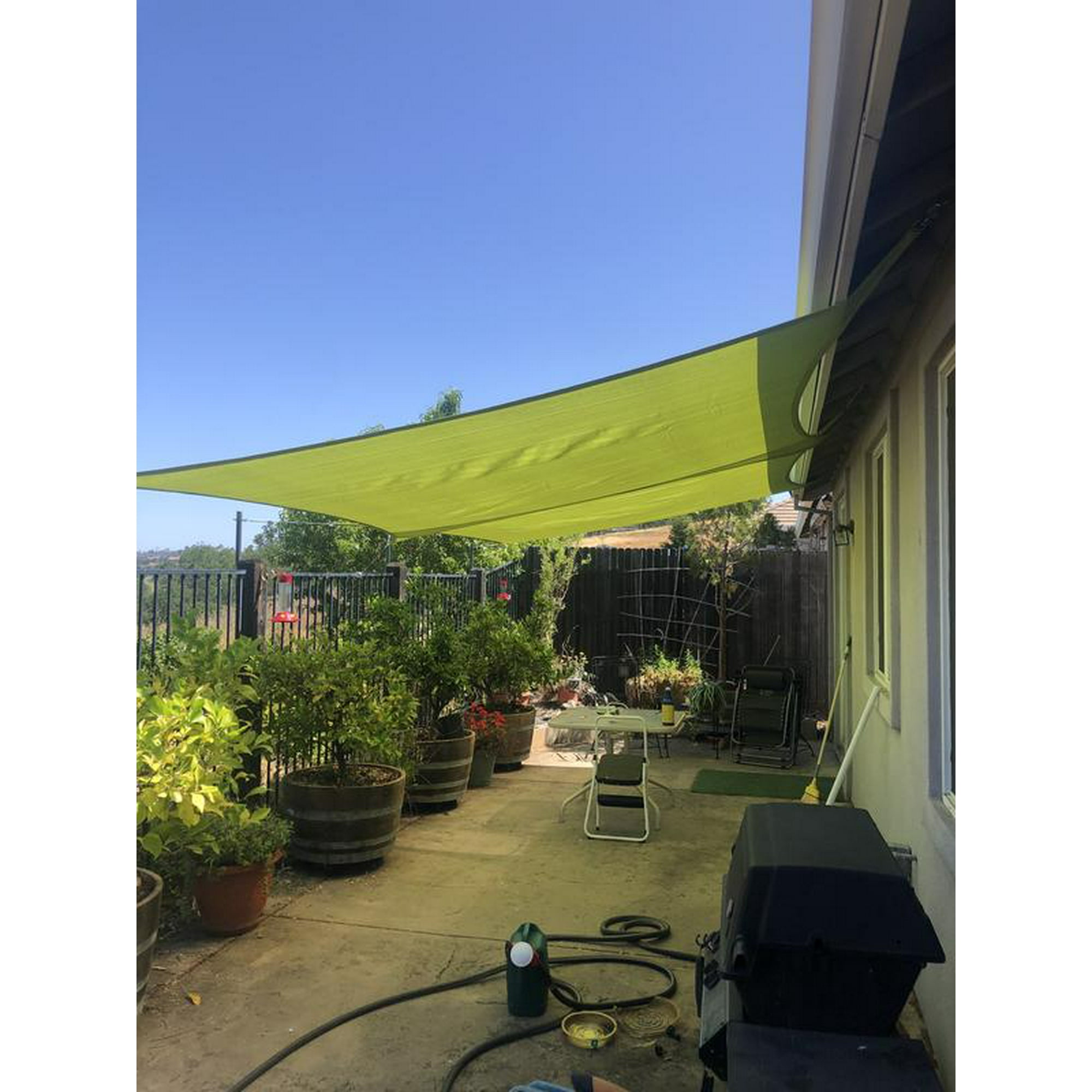
Don’t want to wait years for a tree to grow? Create instant shade with a shade sail, umbrella, or pergola. Many mobile home owners install a simple triangular shade sail over a patio or sandbox – it’s a DIY-friendly project and can be quite affordable. You can also use a retractable awning or a big patio umbrella to cover a seating area. These solutions are lifesavers in sunny states like California, providing a cool retreat from the sun (5 Simple Outdoor Space Upgrades for Your Mobile Home) on scorching days. They also protect kids from UV rays during midday play. A pergola (even a small kit pergola) is another option if you want something more permanent – you can grow vines over it for added shade and beauty. By adding shade, you’ll find your family uses the yard a lot more, since there’s a comfy place to relax without everyone melting in the sun.
This bestselling triangle shade sail takes 10 minutes to install and costs less than $40 — click here to create a cooler play area this weekend.
Outdoor Storage Solutions

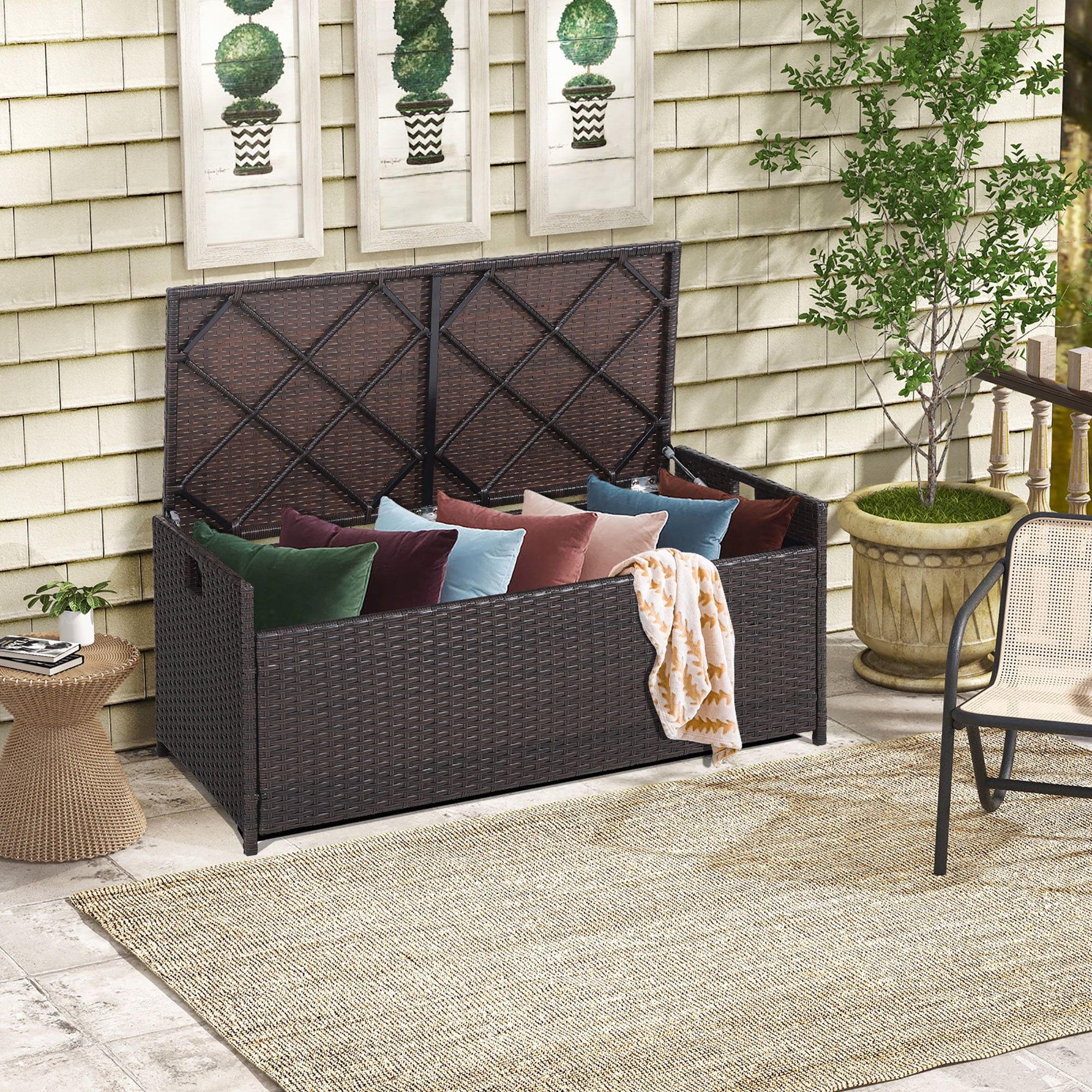
Why It’s Great: It serves a dual purpose- it hides toys, tools, or garden gear, and gives you a cozy spot to sit and watch the kids play. It is also weather-resistant and family-friendly.
If your yard is anything like mine, outdoor toys and tools tend to scatter everywhere. Solve the clutter (and remove tripping hazards) by adding outdoor storage. This could be as simple as a weather-proof deck box or a cute storage bench that holds balls, garden tools, and pool noodles. A small shed (even a low-cost resin one) in the corner of the lot is great for bikes, lawnmowers, or seasonal gear. By giving everything a home, you’ll keep your yard tidier and safer for kids to run around. As a bonus, many storage benches double as extra seating – perfect for when friends come by. And if your mobile home has skirting, remember you can use the underneath area for storage too if it’s accessible; good skirting creates a crawlspace-like storage spot for seldom-used items (Low-Maintenance Landscaping Tips for Mobile Homes – Four Star Homes). Overall, organizing with outdoor storage will reduce stress and cleanup time, so you can focus on family fun instead of yard chores.
Mulch and Pebbles to Tame Weeds (and Mud)

For a low-maintenance yard facelift, mulch is a mom’s best friend. Spreading wood mulch or decorative pebbles over bare soil instantly makes the space look neater and keeps weeds at bay (5 Simple Outdoor Space Upgrades for Your Mobile Home). No more spending every weekend pulling dandelions! Mulch also helps retain moisture in the soil, meaning any plants you do have will need less frequent watering (Creative Ideas for Landscaping Around Your Double Wide) – a nice perk if you live in a drier region or just don’t want to drag the hose out daily. Consider mulching around the perimeter of your home, under shrubs, or in any flower beds. It gives a clean, finished look and prevents muddy areas when it rains. In play areas, pea gravel or wood chips can also be used to create a clean floor (as long as kids are past the “put everything in mouth” stage). And here’s a California tip: if you’re in a fire-prone area, opt for gravel or stone mulch near the home instead of wood mulch, since rocks are more fire-resistant. Either way, you’ll spend less time weeding and more time enjoying your spruced-up yard.
Go Drought-Tolerant with Native Plants

Love a garden but hate the upkeep? Choose drought-tolerant plants that thrive on neglect (almost). In many parts of the U.S. – especially California and the Southwest – swapping thirsty lawn or exotic plants for natives and succulents is a smart move. These plants love low-water conditions and often require minimal care, saving you hassle and money. For example, cacti, agave, lavender, and rosemary can flourish with little to no watering, requiring minimal effort and saving homeowners money (A Beginner’s Guide to Drought-Tolerant Landscaping in California). Native grasses or groundcovers can replace traditional grass lawns so you don’t need to mow weekly. Not only will a drought-tolerant landscape reduce your water bills, it’s usually better for local ecology (think less fertilizer, more pollinators). To keep things kid-friendly, you can focus on soft succulents (like sempervivums or “hen and chicks”) and sturdy natives that won’t poke or be poisonous – always double-check plant safety. By designing with climate-appropriate plants, you’ll have a vibrant yard that practically takes care of itself even in a hot California summer or a dry spell.
Colorful Flower Beds for Curb Appeal

Sometimes a pop of color is all your mobile home exterior needs to go from drab to fab. Planting a small flower bed along the front or sides of your home adds instant cheer and curb appeal. You can line the perimeter with blooming perennials or seasonal annuals that brighten your entryway (Low-Maintenance Landscaping Tips for Mobile Homes – Four Star Homes). For example, marigolds, petunias, or geraniums are affordable and easy for beginners. If you have a tiny yard, even a narrow border of flowers or a couple of well-placed rose bushes can make a big visual impact. Besides looking pretty, flowers can create a nicer environment for your family – attracting butterflies, providing nice scents, and giving the kids something fun to help water. This kind of landscaping is noted as a huge first-impression booster for any home, often even increasing resale value a bit by making the home look well-cared-for (5 Proven Strategies to Boost the Resale Value of Your Mobile Home). And don’t worry, you can opt for low-maintenance blooms: perennials like coneflowers or Black-eyed Susans will come back every year with little effort (Creative Ideas for Landscaping Around Your Double Wide). So go ahead and get those blooms in – your home will feel more welcoming to both your family and your neighbors.
Container Gardens (Portable and Easy)

No permission to dig up the yard? No problem! Embrace container gardening – basically, plants in pots, barrels, or other containers that you can place around your outdoor space. This is ideal for mobile home parks where you may not own the land or if you have a patio instead of soil. You can grow anything from flowers to herbs and even dwarf citrus trees in containers. Arrange a few pretty pots by your front steps or hang baskets under your window for a splash of greenery. Containers let you maximize space using vertical gardening or raised planters (5 Simple Outdoor Space Upgrades for Your Mobile Home) (for example, a tiered plant stand or wall-mounted planters). They’re also easy to rearrange; you can move them to catch the sun or shade as needed. Many moms love container gardens because they’re manageable – less weeding, and you can control soil quality and pests more easily. Try letting the kids each choose a plant for their own pot to take care of; it’s a sweet way to get them involved in the outdoors. With colorful pots and creative placement, container gardens add personality and life to your mobile home lot without the commitment of in-ground planting (5 Simple Outdoor Space Upgrades for Your Mobile Home).
Start a Tiny Vegetable or Herb Garden

There’s something magical about growing food with your family, even if it’s just a couple of tomato plants or a patch of basil. If you have a sunny spot, carve out a small vegetable or herb garden. It could be a little raised bed in the corner of the yard or even a few large containers on the porch (vegetables do great in pots too). This not only provides fresh produce for your kitchen, but it becomes a fun educational activity for kids – they’ll love watering and watching veggies grow. You can blend an edible garden into your landscaping by edging it with flowers or placing it along the side of the home. Don’t be afraid to start small: a 4’x4’ raised bed or a trio of pots with tomatoes, peppers, and mint can yield a lot. Even a beginner can succeed by using starter plants from a nursery and good potting soil (Low-Maintenance Landscaping Tips for Mobile Homes – Four Star Homes). Gardening in a mobile home community is possible and rewarding, and it shows buyers that even a small lot can be productive (a nice resale point). Plus, the family bonding time pulling carrots or picking cherry tomatoes is priceless – it encourages everyone to spend more time outside together, connecting with nature and each other.
Grow fresh flavor right outside your door with SeedsNow's beginner-friendly Herb Garden Variety Pack. It includes organic, non-GMO seeds like basil, cilantro, dill, and more — perfect for patio pots or raised beds. These seeds are curated for small-space gardeners and come with planting tips, making them ideal for new growers.
Upgrade Your Mobile Home Skirting


(Home Depot)
Why it’s great: Creates a high-end look affordably. Lightweight, DIY-install, and weatherproof. Great resale value booster.
Here’s an often-overlooked project that can dramatically improve your mobile home’s exterior – better skirting. The skirting is the material around the bottom of your home that covers the foundation or trailer frame. If your current skirting is old, damaged, or just plain unattractive, upgrading it will instantly tidy up your landscape. New vinyl or faux-stone skirting panels can give a more polished look (there are even faux rock options that look high-end). Beyond looks, skirting serves many purposes: it hides the structural bits, keeps pests out, reduces moisture under the home, and provides insulation (9 Ways to Add Value to Your Mobile Home | Sellers Guide | MHVillage). By repairing or replacing it, you improve both aesthetics and function. You can also get creative by adding small flower beds or decorative rocks along the skirting to make it blend into the landscape (many people landscape around the perimeter of their mobile home for a cohesive look (10 Great Landscaping Ideas for Mobile Homes)). Good skirting and a bit of landscaping around it will make your home appear more permanently set and well-maintained, which can increase its value and curb appeal (9 Ways to Add Value to Your Mobile Home | Sellers Guide | MHVillage). It’s like giving your home a proper “base” in the yard so it doesn’t look like a temporary trailer, but rather a cozy cottage with a finished foundation.
Build a Simple Walkway or Path

If you’re tired of trudging through dirt or wet grass to get to your door, consider adding a small walkway. This can be very budget-friendly and DIY – for instance, lay down some stepping stones or concrete pavers from the driveway to your front steps. You could also use gravel or mulch to define a path. A defined walkway not only keeps shoes cleaner (less mud tracked inside), but it also makes your home entry safer and more inviting. No more stepping in a puddle or on a hidden toy in the dark! If you have kids with bikes or scooters, a smooth path gives them a little track to ride on as well. For a polished touch, line the path with inexpensive solar lights or low plants. Even a short path leading to the patio or around the side of the house adds structure to the yard and boosts that cared-for look. It’s a functional upgrade that subtly improves daily life – you’ll appreciate having a clear route when carrying groceries or a sleeping toddler inside. And if you ever sell, buyers will notice and value the convenience of a proper walkway (it’s one of those small improvements that go a long way in making a property feel like a “home”).
Add Outdoor Lighting for Safety and Ambiance

A little lighting can completely change how your outdoor space feels in the evenings. Try adding solar-powered stake lights along your walkways or around the patio – they’re inexpensive and charge by day to give a soft glow at night (Low-Maintenance Landscaping Tips for Mobile Homes – Four Star Homes). This makes it safer to navigate after dark (no more stumbling on that step) and also extends the usable time of your yard. For a cozy touch, string up some LED string lights along your porch railing, fence, or between posts. It creates a magical, warm atmosphere perfect for summer nights or gatherings. Remember, bright floodlights might irritate neighbors, so stick to gentle lighting. Many mobile home moms swear by those dusk-to-dawn solar lights for zero-maintenance illumination. Lantern-style lights near the front door or solar sconces on the skirting can also dress up the home’s exterior. With proper lighting, you can comfortably have BBQ dinners or watch the kids chase fireflies in the yard even after sunset. It’s all about making your outdoor area more welcoming and secure when the sun goes down, without adding to your energy bill (Low-Maintenance Landscaping Tips for Mobile Homes – Four Star Homes).
Create a Cozy Seating Area (Porch or Patio Set)

Turn your outdoor space into an extension of your living room by setting up a comfy seating area. This could be on your existing porch/deck or right on the lawn under a tree or canopy. A simple setup might be a couple of lawn chairs and a small table, or a bench swing if you have a sturdy overhead beam to hang one. If you have a porch, adding a rocking chair or a cute outdoor loveseat with cushions instantly makes it more inviting (Low-Maintenance Landscaping Tips for Mobile Homes – Four Star Homes). For a budget route, look for second-hand patio furniture or DIY some pallet furniture with weatherproof pillows. The goal is to have a spot where you (and maybe a friend or two) can sit with a cold drink while watching the kids play. It encourages the whole family to spend more time outside together – whether it’s storytelling in the evening or just relaxing on a Sunday afternoon. You can decorate the seating area with personal touches like an outdoor rug, throw pillows, or even hanging flower baskets and wind chimes for a boho vibe (Low-Maintenance Landscaping Tips for Mobile Homes – Four Star Homes). Making a little “outdoor living room” signals to everyone (including yourself!) that the yard is a space to enjoy, not just look at. Plus, a well-staged seating nook can charm potential buyers, helping them imagine pleasant family time in that space.
Set Up a Fire Pit or BBQ Corner

One way to bring the family together outdoors is around food and fire – think evening barbecues or roasting marshmallows under the stars. If allowed in your community, designate a corner of your yard as the fire pit / BBQ area. You can buy a small portable fire pit (or build a simple one with pavers) to safely contain a campfire. Arrange a few chairs or logs around it to create a cozy gathering spot for friends and family (Creative Ideas for Landscaping Around Your Double Wide). For safety, place it a good distance from the home and any overhanging branches, and always supervise kids closely. In fire-prone areas like parts of California, you might opt for a propane fire table or an electric “fireplace” heater to avoid open flames, while still getting that warm ambiance. Alternatively or additionally, set up your grill with a little prep table – making an outdoor kitchen vibe. A BBQ area means summer dinners can move outside, and the mess (and heat) of cooking stays out of your kitchen. These additions become a focal point for outdoor fun (5 Simple Outdoor Space Upgrades for Your Mobile Home): think s’mores nights, backyard camping pretend-play, or simply a place to unwind after a long day. As a perk, a well-done fire pit or patio area can increase your home’s appeal – buyers envisioning themselves enjoying the space might be willing to pay a bit more for that lifestyle.
Add Fun Play Features for Kids

To truly make the yard a family zone, include a dedicated play feature or two for the kiddos. This doesn’t have to mean a giant playground set (though if you have space and budget, a small swing set or slide is awesome). Even in a small mobile home yard, you can get creative: perhaps a sandbox or sand table for sensory play, a DIY mud kitchen, a mini rock-climbing wall secured against a fence, or a chalkboard painted on the side of a shed for artistic fun. If there’s a tree, maybe hang a tire swing or a hammock – adults love hammocks too! For a toddler-friendly idea, set up a simple water play station with tubs or a splash pad in summer. Involving some play equipment not only entertains the children but also encourages them to spend more time outside (which means less screen time and more naps later – win-win). It can be as simple as a grassy spot cleared for tag and ball games or as elaborate as a custom treehouse (if you’re a super DIY mom or want to hire a pro). The key is to tailor it to your kids’ interests and safety level. A well-thought-out play area on your property also signals to future family buyers that this is a fun, family-ready home. Just remember to maintain it (check that swing set is sturdy, refresh the sandbox sand, etc.) so it stays safe.
Control Erosion with Groundcover or Terracing

If your lot has a slope or bare soil that tends to wash out in heavy rain, address it with some simple erosion control landscaping. One solution is to plant hardy groundcover plants on the slope – things like creeping thyme, ivy, or low-growing junipers can anchor the soil with their roots and form a protective carpet of foliage (10 Best Plants to Control Erosion in Your Yard). This prevents your yard from losing soil every time it storms, and it looks nicer than an eroded dirt bank. Groundcovers are generally low-maintenance (many are evergreen and spread on their own) so they also save you mowing awkward slopes. Another idea is terracing: you can create one or two small retaining walls using landscape timbers or stone to make flat terraces on a hill. This not only stops erosion but also gives you usable little garden beds on each level. You might plant one terrace with flowers and another with veggies, for example. If DIY, start with modest heights or get a contractor for bigger walls. By managing erosion, you’ll protect your home’s foundation and the neighborhood (less runoff mess) while improving your yard’s stability and look. It’s an upgrade that shows you’ve cared for the property’s long-term health, which can be a selling point too.
Low-Maintenance Lawn Alternatives (Turf or Clover)

Dreaming of a green play lawn but dread the upkeep of grass? Consider replacing or reducing your natural grass with a low-maintenance alternative. One popular option is artificial turf for a small yard – today’s turf looks pretty real and gives you a year-round green patch with no watering and no mowing needed (The Benefits and Solution of Artificial Turf for Your Home). Many families install a bit of turf for a clean, mud-free zone where kids can roll around or set up a sprinkler, and it can save thousands of gallons of water annually in dry regions (The Benefits and Solution of Artificial Turf for Your Home). If you prefer living plants, look into eco-lawns or groundcovers: for example, a clover lawn stays green, needs minimal mowing, and is soft for kids. There are also mixes of drought-tolerant grasses that grow slowly and require less care. The idea is to reduce the maintenance burden – freeing you from constant mowing, edging, fertilizing, and high water bills. In places like California with water restrictions, replacing a traditional lawn with xeriscaping (rocks, mulch, native plants) or synthetic turf can even earn you rebates and definitely makes your home more future-proof. A nice bonus: a neat, always-green yard (even if it’s artificial or alternative groundcover) boosts curb appeal, and buyers will appreciate a yard that’s beautiful without the heavy upkeep.
Personal Touches (Bird Feeders, Wind Chimes & More)


Finally, don’t forget the little touches that make your outdoor space feel like home. Adding a few personal, sensory-friendly elements can transform your yard from plain to delightful. For example, hang a bird feeder or a bird bath to invite songbirds – kids love watching birds visit, and it helps with pest control too (bye bye, mosquitoes!). Bird feeders and baths will attract our feathered friends for a lively yard (Low-Maintenance Landscaping Tips for Mobile Homes – Four Star Homes). Wind chimes or suncatchers hung on the porch can create gentle sounds and colorful light sparkles that make the space calming and magical (just avoid extremely loud chimes if neighbors are close). You could also place some garden art or gnomes, paint a few rocks with the kids to dot along the flower bed, or set up a small bubbling fountain for the soothing sound of water. These decorative touches are usually low-cost but high in charm, and they engage the senses – great for kids who enjoy tactile and auditory stimulation in the garden. They also reflect your personality, making the yard uniquely yours. Remember, a well-loved outdoor space isn’t just about function – it’s about joy and relaxation. By sprinkling in these personal touches, you create a yard that’s not only functional and attractive, but also full of heart and family memories.
Improving a mobile home landscape is absolutely doable, even on a budget and limited space. By mixing practical fixes (like drainage and fencing) with creative enhancements (like planters and play areas), you can solve common problems and create an outdoor oasis for your family. Many of these ideas will not only make daily life happier and easier (less mud, more privacy, safe play), but could also boost your home’s curb appeal and value in the long run. Pick a few projects that resonate with you and give them a try. Before you know it, you’ll have a yard where the kids can play safely, the adults can relax, and even the neighbors will comment on how lovely and purposeful your space looks. Enjoy your DIY journey, and don’t forget to invite a fellow mom over to bask in your new-and-improved outdoor haven – after all, you earned the right to show it off!

